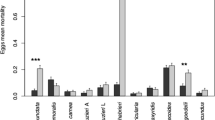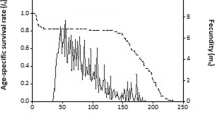Abstract
Eight insect predators common in the rice ecosystem in the Philippines were compared in the laboratory on their ability as to feed on the eggs of green hairy caterpillar,Rivula atimeta Swinhoe. A ranking, based on feeding rates was made:Metioche vittaticollis (Stål) (Gryllidae) was the most voracious predator, followed byAnaxipha longipennis (Serville)(Gryllidae), Ophionea nigrofasciata (Schmidt-Goebel)(Carabidae), Micraspis nr.crocea (Mulsant) (Coccinellidae) andConocephalus longipennis (de Haan) (Tettigoniidae). Also the smallCyrtorhinus lividipennis Reuter (Miridae), readily fed upon the eggs.Paederus fuscipes Curtis (Staphilinidae) andCoccinella repanda (Thunberg) (Coccinellidae) fed to a very limited extent.Metioche vittaticollis andCyrtorhinus lividipennis were also tested on eggs of green semilooper,Naranga aenescens Moore, and rice whorl maggot,Hydrellia philippina Ferino. The feeding rate ofM. vittaticollis was similar on the 3 different preys, butC. lividipennis had a higher feeding rate onN. aenescens eggs.
In 1.6 m2 field cages, different densities ofM. vittaticollis andO. nigrofasciata were allowed to feed on exposedR. atimeta eggs during 2 days.Metioche vittaticollis consumed 13 and 26 eggs at predator densities of 1 and 2 per cage respectively, but was not much higher at density 8. Predation byO. nigrofasciata was not significant.
Résumé
Huit insectes prédateurs communs dans l'écosystème du riz aux Philippines ont été comparés au laboratoire pour leur capacité à se nourrir sur les œufs de la chenilleRivula atimeta Swinhoe. Une échelle basée sur les taux de prédation a été établie:Metioche vittaticollis (Stal) (Gryllidae) était le prédateur le plus vorace suivi parAnaxipha longipennis (Serville)(Gryllidae), Ophionea nigrofasciata (Schmidt-Goebel)(Carabidae), Micraspis nr.crocea (Mulsant) (Coccinellidae) etConocephalus longipennis (de Haan) (Tettigonidae). Le petit Miride,Cyrtorhinus lividipennis, se nourrissait aussi facilement sur les œufs.Paederus fuscipes (Curtis) (Staphilinidae) etCoccinella repanda (Thunberg) (Coccinellidae) se nourrissait dans une mesure très limitée.Metioche vittaticollis etCyrtorhinus lividipennis ont été aussi testés vis-à-vis des œufs de la NoctuelleNaranga aenescens Moore et de la Mineuse du Riz,Hydrellia philippina Ferino. Le taux de prédation deM. vitaticollis était identique sur les trois proies, maisC. lividipennis manifestait un taux de prédation plus élevé sur les œufs deN. aenescens.
Dans les cages de plein air, de 1,6 m2, on permettait à différentes densités deM. vittaticollis et d'O. nigrofasciata de se nourrir sur des œufs deR. atimeta exposés durant deux jours.Metioche vittaticollis consommait 13 et 26 œufs aux densités respectives de 1 et 2 prédateurs par cage, mais la prédation n'était pas beaucoup plus élevée à la densité de 8. La prédation due àO. nigrofasciata n'était pas significative.
Similar content being viewed by others
References
Balk, F. & Koeman, J. H. — 1984. Future hazards from pesticide use. —The Environmentalist, 4, Suppl. No. 6, 100 p.
Chelliah, S. &Heinrichs, E. A. — 1980. Factors affecting insecticide-induced resurgence of the brown planthopper,Nilaparvata lugens, on rice. —Environ. Entomol., 9, 771–777.
Chui, C. S. — 1979. Biological control of the brown planthopper. In: Brown planthopper—a threat to rice production in Asia. —Intern. Rice Res. Inst. Los Baños, Philippines, p. 335–355.
FAO — 1982. Integrated pest control in agriculture. —Report of the 1 th session of the FAO/UNEP panel of experts meeting. Kuala Lumpur, Malaysia, 5–10 March 1982.
Greathead, D. J. — 1983. Natural enemies ofNilaparvata lugens and other leaf-and planthoppers in tropical agroecosystems and their impact on pest populations. In: 1st International Workshop on Biotaxonomy of Leafhoppers and Planthoppers (Auchenorryncha) of Economic Importance, London, 4–7 October 1982 (W. G. Knight, N. C. Pant, T. S. Robertson &M. R. Wildon, eds.). —Commonw. Inst. of Entomol., London, p. 371–383.
Heinrichs, E. A. &Mochida, O. — 1984. From secondary to major pest status: the case of insecticide-induced rice brown planthopper,Nilaparvata lugens, resurgence. —Prot. Ecol., 7, 201–218.
Kenmore, P. E., Carino, F. O., Perez, C. A., Dyck, V. A. &Gutierrez, A. P. —1984. Population regulation of the rice brown planthopper,Nilaparvata lugens (Stål), within rice fields in the Phillippines. —J. Plant Prot. Tropics, 1, 19–37.
Kiritani, K. — 1979. Pest management in rice. —Annu. Rev. Entomol., 24, 279–312.
Lim, G. S. — 1974. Potential for the biological control of rice insect pests. —MARDI Rep., 22, 1–27.
Metcalf, R. L. — 1984. Trends in the use of chemical insecticides. In: Proc. FAO/IRRI Workshop on Judicious and Efficient Use of Insecticides on Rice. —Intern. Rice Res. Inst., Los Banos, Philippines, p. 69–91.
Ooi, P. A. C. — 1982. A surveillance system for rice planthoppers in Malaysia. In: Proc. Int. Conf. Plant Prot. Trop., Kuala Lumpur. —Malaysia Plant Prot. Soc., p. 551–565.
Reissig, W. H., Heinrichs, E. A. &Valencia, S. L. — 1982. Insecticide-induced resurgence of the brown planthopper,Nilaparvata lugens, on rice. —Environ. Entomol., 11, 165–168.
Shepard, B. M. &Arida, G. S. — 1986. Parasitism and predation of yellow stemborerScirpophaga incertulas (Walker) [Lepidoptera: Pyralidae] eggs in transplanted and direct seeded rice. —J. Entomol. Sci., 21, 26–32.
Shepard, B. M., Ferrer, E. R. &Kenmore, P. E. — 1988. Sequential sampling of planthoppers and predators in rice. —J. Plant Prot. Tropics, 5: 39–44.
van den Berg, H., Shepard, B. M., Litsinger, J. A. &Pantua, P. C. — 1988. Impact of predators and parasitoids on the eggs ofRivula atimeta, Naranga aenescens [Lepidoptera: Noctuidae] andHydrellia philippina [Diptera: Ephydridae] in rice. —J. Plant Prot. Tropics, 5, 103–108.
Wongsiri, T., Wongsiri, N., Tirawat, C., Navavichit, S., Lewvanich, A. & Yasumatsu, K. — 1981. Abundance of natural enemies of rice insect pests in Thailand. —Proc. Symp. Trop. Agr. Res., Kyoto, Aug. 6–7, 1980, p. 131–149.
Yasumatsu, K. — 1982. An illustrated guide to some natural enemies of rice pests in Thailand. —Japan Intern. Cooperation Agency, 72 p.
Author information
Authors and Affiliations
Rights and permissions
About this article
Cite this article
Van Den Berg, H., Litsinger, J.A., Shepard, B.M. et al. Acceptance of eggs ofRivula atimeta, Naranga aenescens [Lep.: Noctuidae] andHydrellia philippina [Dipt.: Ephydridae] by insect predators on rice. Entomophaga 37, 21–28 (1992). https://doi.org/10.1007/BF02372970
Received:
Accepted:
Issue Date:
DOI: https://doi.org/10.1007/BF02372970




